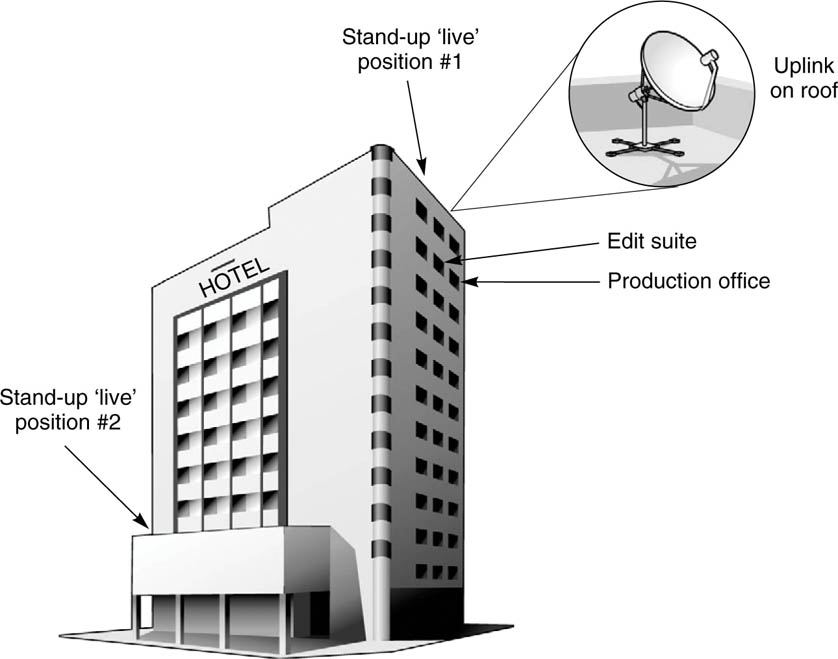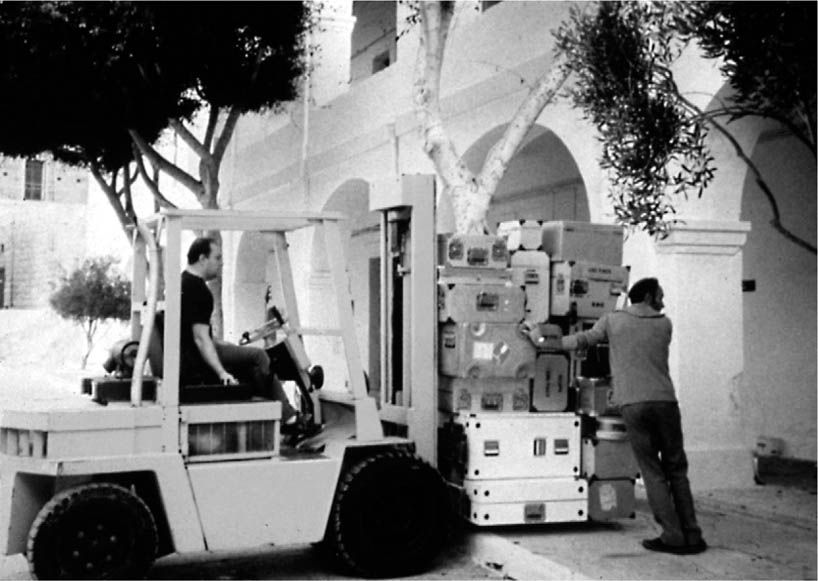Typical flyaway operation
Because there is such a wide variation of situations for flyaway operations, it is perhaps most useful to look at a particular scenario.
Let us imagine that the story is a major international one; for example, in the aftermath of the attacks on New York and Washington of 11 September 2001. During the US reprisals against Afghanistan, there was a major newsgathering presence in Pakistan. All the major TV networks were there, and there was a considerable presence in Islamabad and Peshawar in Pakistan.
A typical operation would have been based at a hotel. Four or five star international chain hotels offer a number of benefits for flyaway operations – there are often extensive grounds or roof areas for the rigging of the flyaway antennas, the crews can stay as well as work in the hotel, and additional rooms can easily be acquired for all the operational activities.
Most of all, in a hostile situation international hotels are often the safest places to be.
Supposing that this operation is rigged at a hotel, then the uplink will probably be on the roof with a power generator.
Although local power from the hotel is available and used, it is usual to back this up with your own source of power. The most common requirement is to be able to do stand-up ‘lives’ and replay tape material.
This means providing a live camera position, with studio-remote communications and some audio mixing for the reporter and perhaps a guest contributor, and also a VTR to play in material live or feed back to the studio for later transmission.
There needs to be a small routing switcher, able to synchronously switch (i.e. with no picture roll or glitch) between the output of the camera and the VTR, and some vision and sound monitoring.
The edit suite can be several floors below in a room, while the ‘live’ position may be on the roof or on a room balcony, to give a visual background statement of the location of the story. The switching/monitoring point is likely to be in another hotel room, which often doubles up as a production office.
One of the problems faced in these situations is the amount of signal cabling required.
The cabling requirements are quite considerable, particularly if there is a significant distance between the stand-up live camera position, the edit suite, the switching/monitoring point and the satellite uplink. All too quickly the interconnection requirements can rise to the extent that there may be perhaps over 100 kg of cable alone to be transported to cover hundreds of metres of multiple interconnects.
Let us look at each of the parts of this operation in a little more detail. Many aspects of the operation are identical to what is necessary with a terrestrial ENG microwave operation – because the only thing that is different is the transmission medium.
Hotel scenario

Live position
The live position needs to ‘say’ something about the story. It could be that for safety or practical reasons the live position cannot be in the place where you would ideally like it to be, but nevertheless you have to pick as good a position as possible.
Often the producer or reporter will decide where the live position should be, but hopefully they will get the opinion from the technicians as to the feasibility of its situation. The background has to ‘set the scene’, perhaps with a well-known landmark – but often you do not have that luxury.
Wherever it is, it has to be safe and practical to work from. You may be squashed up with three other live positions of other broadcasters, so you just have to make the best of it and obtain a decent shot for the news editor.
Studio-remote communications
Communications with the studio in SNG operations always involve comms circuits such as two-way talkback (4-wire) and IFB.
Other communication circuits will include a number of telephone lines and a data connection with the newsroom computer system.
These can all be provided either via an additional transmit/receive equipment on the satellite uplink (sometimes referred to as commslink), via an Inmarsat satphone (we will look at these later), or via any available telephone landlines.
The most desirable method of delivery is via the satellite uplink, as this usually provides the most direct paths to and from the studio.
The connection to the newsroom computer system and the provision of multiple telephone circuits are critical. The integration of the newsroom computer system into the overall news production process means that it acts as the heart of both the newsgathering and the news output operation. Information regarding contacts, running orders, news agency wire information and background information to the story are all controlled and produced by the newsroom computer system, as well as providing rapid messaging between the editorial staff and the field staff. It is also a fact that there can never be too many telephones – you will always have someone needing to make calls!
No matter how simple the operation, however, this aspect of the news broadcasting chain is vital. Many operations have failed not for lack of programme pictures and sound, but because the studio-remote communications have not been working correctly.
Commslink
The provision of IFB, talkback, telephone circuits, and the connection to the newsroom computer system can all be provided via an additional transmit/receive side-chain on the satellite uplink. The comms is uplinked as a separate carrier in the same frequency band as the main programme uplink channel, and is typically at a data rate of 64 kbps – hence it is common to talk of comms ‘channels’ in terms of 64 kbps slots.
The comms carrier does not need to be transmitted at as high a power level as the main programme signal, because of the much smaller bandwidth requirement of the data carrier of the comms. It is combined with the main outgoing programme signal just before the HPA.
If it is a simple comms system, with just a single audio ‘go’ and ‘return’ for IFB, then the signals can be sent and received via a comms modem. For a more complex system, a ‘statistical’ data multiplexer is used that can vary the allocation of the relatively narrow data bandwidth of each of the audio channels according to the wider simultaneous bandwidth demand of a number of circuits.
The use of an integrated communications system with the uplink is highly advantageous, from both a cost and a convenience point of view, as the bandwidth and power requirements of the comms carriers on the transponder are much lower than for the main programme channel, and hence much cheaper.
Video editing
In addition, it is often a requirement to provide a video editing facility at the uplink location, and if this edit suite is required to be a source to the routing switcher as well, then this will further complicate the system.
The format of the video editing varies according to the organization, but Sony SX and Panasonic’s DVCPro digital tape formats are replacing the once dominant older analogue Sony BetaSP format. DVCam, originally intended only as a domestic format, is also increasingly in use as a budget newsgathering format.
The appeal of the digital formats in the field are the compact laptop editors, weighing under 10 kg, which considerably reduce the average 150 kg of equipment that traditionally made up a BetaSP edit pack.
Whatever the format of the video editing, it is common to try to provide the ability to connect the editing as an online facility to the rest of the rig. This is so that an edited piece (a cut) that has just been finished can be immediately played out on the satellite uplink, without the necessity to take the tape to a separate VTR for playout.
Electrical power
Because mains power may not be available or if it is, may not be very reliable, a power generator is required as well. Because some of the live-shots may take place at night or under bright sun, either of which will require additional lighting for the live stand-up position, the generator will need to be capable of delivering suitable levels of power.
The uplink system itself may require quite a significant amount of power, so the generator (or generators) will need to supply typically somewhere between 5 and 20 kW, depending on the overall demand.
Generators are one of the most common reasons for failures in the operation of SNG uplink systems. There is a maxim that a generator will always fail (it is just a matter of when) as they are notoriously unreliable – not helped by the less than ideal conditions they are often operated in.
The challenges
On covering a story like this, it is critical to get to the location and rig as fast as possible. The whole system has to be built, tested and be operational in typically about 12–18 hours from arrival on location – and that does not include getting through the Customs formalities and travelling from the airport.
All these elements also mean that the total number of cases that make up the entire system as we have discussed will probably double or triple the number of cases that make up the basic SNG uplink alone.
The truth is that to mount an operation as described above, there is likely to be a total of 40–50 cases, and the total weight of the cases between 1000 and 1500 kg (see opposite).
With the new ‘lightweight’ DSNG systems, this shipped weight can be reduced, but perhaps not as dramatically as might be assumed. Although there are complete lightweight SNG flyaway systems that claim to have a shipping weight near to 250 kg, production demands can quickly increase this weight.
This in turn can mean that the system described above has to be expanded to meet this greater demand, and the net result can be just as much equipment has to be provided.
However, it is possible with determination – both technical and editorial – to ‘travel light’ and to keep the amount of equipment required under 600 kg, and on certain stories this may be essential for logistical and safety reasons.
Typical SNG flyaway system – packaged to go!

Often on this type of story there will be other staff engaged locally – ‘fixers’, translators, drivers, etc.
A fixer is someone who has a good deal of local knowledge, and as the name suggests, be able to ‘fix’ things from finding and making the contacts for interviews, to liasing with local officials to make sure the whole operation runs as smoothly as possible.
